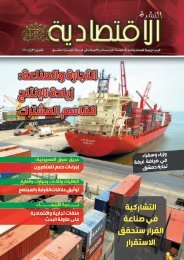SIGAR
2017-01-30qr
2017-01-30qr
You also want an ePaper? Increase the reach of your titles
YUMPU automatically turns print PDFs into web optimized ePapers that Google loves.
AFGHAN PROCUREMENT REFORM<br />
Conflict: Lessons from the U.S. Experience in Afghanistan. For years after<br />
the 2001 intervention in Afghanistan, <strong>SIGAR</strong> noted, “The U.S. government<br />
. . . failed to recognize that billions of dollars injected into a small, underdeveloped<br />
country, with limited oversight and strong pressures to spend,<br />
contributed to the growth of corruption. . . . The influx of money from aid<br />
and military contracts was not always accompanied by strong oversight.<br />
Controls were sometimes insufficient to prevent embezzlement, bribery,<br />
fraud, and other forms of corruption—by both Afghan and international<br />
actors—that drained resources from the reconstruction effort.” 13<br />
These and like concerns have been noted by other oversight bodies:<br />
• A 2008 report by the Public Procurement Unit of the Afghan Ministry of<br />
Finance noted that ongoing reforms were then attempting to address<br />
issues including “limited procurement capacity at all levels in the<br />
government,” lack of adequate training, inadequate regulations, nonuniform<br />
procurement structures among agencies, and “no incentives<br />
for improvement and ownership.” 14 The Commission on Wartime<br />
Contracting in Iraq and Afghanistan estimated in its 2011 final report<br />
that “At least $30 billion, and possibly as much as $60 billion, has been<br />
lost to contract waste and fraud” in the contingency operations in the<br />
two countries. 15 U.S. aid has continued to both countries, especially to<br />
Afghanistan, where more than $8.4 billion of the $117 billion already<br />
appropriated has yet to be disbursed, and the United States has<br />
committed to spend billions more for years to come.<br />
• In November 2016, the independent organization Integrity Watch<br />
Afghanistan (IWA) declared that “In the last 14 years, the Afghan<br />
government has failed in the fight against corruption. . . . Lack of<br />
political will and inappropriate institutional arrangements were<br />
amongst the key factors behind the total failure.” The IWA did, however,<br />
see some progress in the establishment of external oversight of the<br />
procurement process through the National Procurement Commission<br />
and the National Procurement Authority. 16 Working with civilsociety<br />
experts, international representatives, and Afghan officials,<br />
Transparency International found last year that only two of 22 Afghan<br />
anticorruption commitments since 2014 deemed “most crucial to<br />
tackling corruption in Afghanistan” have been fully implemented. 17<br />
<strong>SIGAR</strong> ASSISTANCE TO AFGHAN PROCUREMENT<br />
In addition to <strong>SIGAR</strong>’s work in the MOD fuel-contract case, another <strong>SIGAR</strong><br />
investigation revealed weakness in Afghan ministerial procurement capability<br />
and helped avoid the award of an Afghan ministry of a $99 million<br />
road-building contract to a suspect and weakly credentialed consortium.<br />
In 2015, the Afghan Ministry of Public Works (MOPW) used a sole-source<br />
selection process to award a contract for building two sections of the<br />
REPORT TO THE UNITED STATES CONGRESS I JANUARY 30, 2017<br />
7







